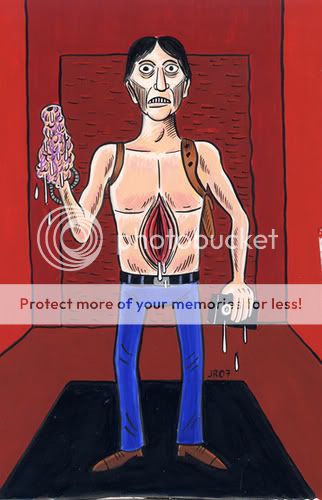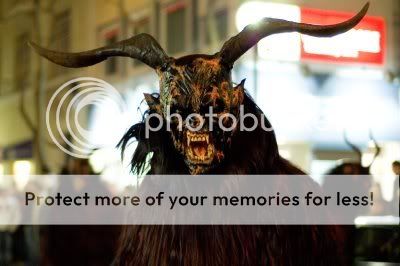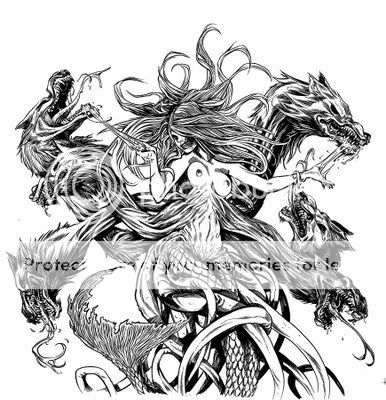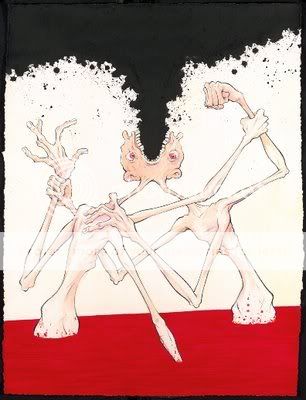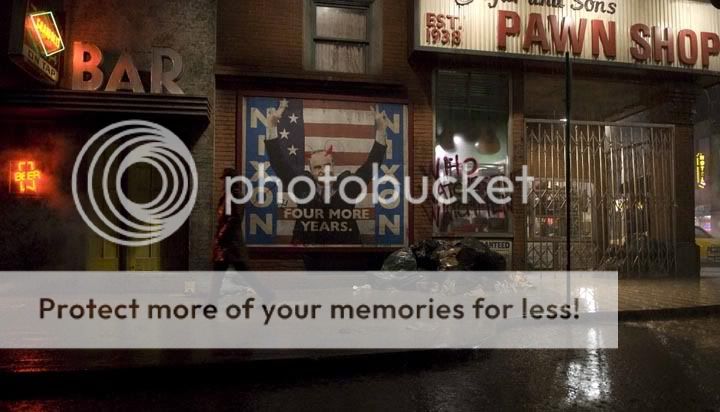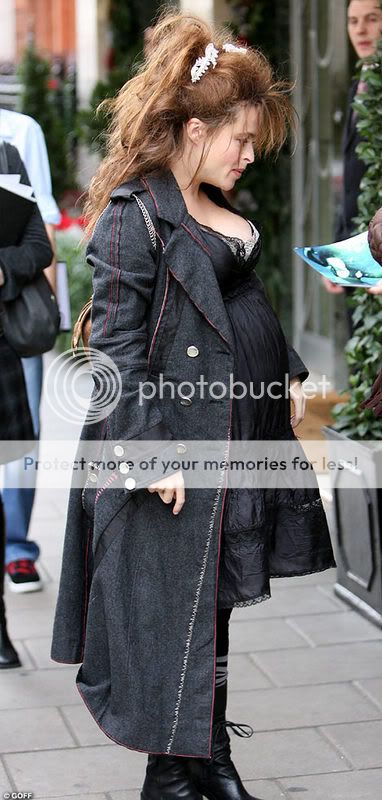The Hellraiser remake has a release date: September 5, 2008. It’s also apparently called Clive Barker Presents: Hellraiser, which is interesting–putting the imprimatur of the original creator on a remake in such an explicit fashion is an unusual move–but may also just be one of those bits of not-quite-accurate information that calcifies into Internet Factdom.
Carnival of souls
Looks like the ranks of those unhappy with J. Michael Straczynski’s “One More Day” Spider-Man storyline include…J. Michael Straczynski, who’s basically throwing “OMD” artist and Marvel Editor in Chief Joe Quesada under the bus for the arc and saying he came this close to asking for his name to be removed from its final two issues. He also cites wanting to have Peter Parker sire illegitimate children by Gwen Stacy as an example of his sound judgment, which is hilarious. (Via every comics blog everywhere.)
Long live the new flesh: Feast your eyes on this Flickr set of “Horrorshow,” Johnny Ryan’s horror and exploitation film-inspired series of paintings. Best part: The originals are on sale! (Via Eric Reynolds.)
It feels like it’s been a long time since I blogged about a good old-fashioned sea monster, which is why it was such a pleasure to come across this article about a newly discovered species of prehistoric, sea-dwelling, carnivorous reptile the size of a bus. Fuck, the dinosaur era was AWESOME.
Aeron at Monster Brains brings us links to several photo galleries’ worth of photos from Austria’s Krampus festivals, celebrations of the mythical devil who hangs with Santa Claus and punishes the naughty children. Some of these costumes are weapons-grade scary.
Glenn Kenny and his commenteers are close-reading the bloody bejesus out of No Country for Old Men. I’m always torn when I see discussions like this going on. On the one hand it takes me back to my film school days, when similar bull sessions frequently lasted until dawn or sobriety intervened. And it’s always fun to watch people geek out so unabashedly about something I love as much as I love film, particularly a great one (and No Country is a great film). On the other hand it edges a little too close to the parlor-game mentality whereby great art is seen to be not just appreciated or understood but decoded, like the Jumble in the funnypages. I don’t think it works that way. I certainly hope it doesn’t. At any rate I’m pretty sure that determining whether or not Chigurh is in a certain room or holding a certain weapon in a certain scene is not some magic key to understanding what it all means. Like, when you watch that movie, don’t you just naturally come away understanding what it all means? Without having to resort to the equivalent of “the walrus was Paul”?
Finally, oh Marty, how I love you. (Bonus points for casting Simon Baker in the Hitchcock hero role. And for Thelma Schoonmaker on-screen. And for the ending.) (Via every movie blog everywhere.)
Beowoof
You know a review’s going to be a doozy when it approvingly asserts in its second sentence that Slate‘s humorless killjoy of a film critic Dana Stevens “spoke for many” about, well, anything. Calling the review “Beowulf: War Porn Wrapped in a Chippendale Dancer’s Body” is probably a tip-off too. And the straight-faced inclusion of the sentence “The three beasts in the film in fact line up pretty well as stand-ins for Iraq, North Korea and Iran” would be exhibit C.
But what really perplexes me about Alexander Zaitchik’s Alternet piece on Beowulf is that it seems to argue that a movie whose main point is that warriors are about 60% bullshit and bluster, 30% greed, lust, and sloth, and MAYBE 10% bravery tops is some sort of paean to the glory of war, then goes on to support this argument, incomprehensibly enough, by calling attention to the film’s anti-Christian strain–only to completely reverse itself in the final paragraph and wonder if the point of the movie is in fact that war is not all it’s cracked up to be.
It’s a real head-scratcher.
(Via The House Next Door’s Links for the Day, which are all pretty great today.)
Does Doyle wink?
Do you know what I’m talking about? I didn’t think he did the first time I watched 28 Weeks Later, and I’m rewatching it and I still don’t think so. But it was obviously in the promos, and I’ve heard people talk about it being in the movie too. Can anyone else out there with the DVD confirm or disconfirm this suspicion?
Also? What a great movie.
Three unconnected thoughts about four unconnected superhero comics
1) Due to a freelance assignment I reread Alan Moore and Brian Bolland’s Batman: The Killing Joke today. As I did it I had in mind the oft-voiced criticism that the book has no relevance to real life, a line taken not just by reviewers but also by, and perhaps most vociferously by, and maybe originally by, Moore himself. I totally disagree. Even if you haven’t been in one yourself, surely you know someone who’s been locked into a mutually destructive love-hate relationship with someone that brings out the worst qualities in both parties. Perhaps you’ve also known someone who is or was, for lack of a better word, addicted to illness. I think there’s at least as much personally relatable heft to the emotional core of this book as there is to, say, the Gordian Knot thing at the end of Watchmen. It’s also a pretty great Batman story in which both he and the Joker are actually pretty scary, which is harder to pull off than most writers seem to think. And Brian Bolland can draw, boy howdy.
2) Over the past few months I’ve talked occasionally about the un-selfconscious craziness of ’80s action movies like Rambo and Invasion U.S.A.. I wonder: are the slick, gratuitously violent superhero comics of today, like Countdown to Final Crisis or Mark Millar’s Wanted, an equivalent entertainment? I mean, there’s caveats in both cases, to be sure: Countdown has that sprawling “to be continued in the pages of Title X” would-be mega-crossover thing going on, and Wanted thinks it’s Fight Club. But both appear to have that love of bloodshed and lack of self-awareness that characterize the slaughterfests of yore. I guess it just comes down to whether they succeed as entertainment, which, well, compared to Road House? Not so much. (I enjoy Wanted well enough, I guess, though the glib rape references leave a terrible taste in your mouth and like all Mark Millar comics the hero just starts winning at the end because it’s time for the hero to start winning.)
3) So I guess it’s now out there that Spider-Man is going to swap his marriage to Mary Jane for the life of Aunt May courtesy of Marvel’s satanic stand-in Mephisto. I try not to comment on these “how dare they” superhero plot points because there are 40,000,000 other blogs where you can find that if you want and because there are more productive ways to spend one’s blogging-about-comics time and energy, but I’ll make an exception here because Spidey was my first superhero favorite as a little guy and because this is just so colossally wrong-headed that it practically demands scorn and derision, like that “rappin’ John Wayne” song from the ’80s.
For starters, it should be self-evident that having your flagship superhero, your exemplar of heroic values and morality, the guy whose book gave us the phrase “with great power comes great responsiblity,” the most popular fictional character in the world whose name isn’t Harry Potter, literally make a deal with the devil is just a terrible, terrible idea on the face of it. That he does so to scrap the romance at the center of his multi-billion-dollar, zeitgeist-bestriding film trilogy should probably have sent up a few red flags too.
But it’s worse still because, much like all the mystical “avatar of the Spider-God” poppycock writer J. Michael Straczynski has shoehorned into the character’s mythos–including his origin, which with Batman’s and Superman’s was among the most famous and note-perfect origins of any heroic character ever as-is–it runs counter to every core aspect of the character: his roots in science fiction, his role as the Marvel superhero community’s everyman in the city, his nature as not some Chosen One blessed and cursed by the gods but just some loser teenager who got dealt a crazy hand by dumb luck.
The final, fatal, unforgivable flaw, of course, is that it doesn’t even work from a standpoint of emotional realism. Simply put, if you ask any happily married couple to trade away their entire marriage, past present and future, to save the life of a septuagenarian mother figure, no matter how beloved, who probably is just a few years from dying anyway, the answer would be no.
Quote of the day
Former prisoners have reported that their captors were expert in two practices in particular: falaqa, or beating suspects on the soles of their feet with a truncheon and then, often, forcing them to walk barefoot and bloodied across a salt-covered floor; and farruj, or the “grilled chicken,” in which prisoners are handcuffed behind their legs, hung upside down by a rod placed behind their knees, and beaten.
–Craig Whitlock, “Jordan’s Spy Agency: Holding Cell for the CIA; Foreign Terror Suspects Tell of Torture,” Washington Post
(Via Andrew Sullivan.)
Quote of the day
Censors don’t read, but they do go to movie theaters.
—Bryan Alexander on the absurdity of protests against the years-old, highly successful His Dark Materials YA fantasy series by Philip Pullman only when its first installment, The Golden Compass, is being made into a motion picture. So you can add “illiterate” to the heap of vituperative adjectives I use to describe the Catholic League. (I went to a Catholic high school, man. Some things you don’t forget.)
Two reviews
At The House Next Door, Ryland Walker Knight reviews The Mist. I’m perplexed by his assertions, which I’ve heard frequently elsewhere, that a) Mrs. Carmody and her religious nuts are scarier than the monsters, and b) the film is more interesting when the survivors interact than when the monsters attack. I think in both cases the answer is quite clearly “no, they’re not” and “no, it’s not,” because of how stock the characters are in both cases. We’ve seen Mrs. Carmody a million times, and nothing interesting is done with her beyond casting Marcia Gay Harden. We’ve seen a disparate group of people thrown together and forced to cooperate to survive a post-apocalyptic world of danger two million times, and usually much more interestingly than this. As I alluded to before, compare this crew and what they do to, for example, the way Ben and Cooper’s behavior and decisions challenge our preconceptions about their competence in Night of the Living Dead, or the warmly multifaceted interpersonal dynamics between Stephen, Peter, Roger, and Francine (including friendship, love, idolization, one-upsmanship, stoicism, panic, foolhardiness…) in the original Dawn of the Dead. Nothing at all like that is going on here; the one big shock is at the end, and as Knight points out, that shock is so sudden it feels like it undercuts the rest of the movie. Arguing that the characters are the best part and that the humans are the scariest part are the sorts of things one is supposed to say about a horror film, but in this case as in many, many others, including many good horror films, they’re not true.
At The Forager, Jon Hastings reviews The Transformers. For the first time he’s made me realize why I’ve been so reluctant to watch it: I was never a big Transformers kid–Star Wars, He-Man, G.I. Joe, and the Teenage Mutant Ninja Turtles were my action figures/media tie-ins of choice, I think probably because the Transformers were really expensive–but in my experience their shows and their movie were really pretty weird. I remember the leaders of both sides dying and floating three-headed robot tribunals and a giant planet that ate other planets and stuff like that. Michael Bay’s vanilla “hey we’re all having fun here!!!!!!!” blockbuster mentality would never capture that weirdness and seriousness.
Under my skin
In this week’s Horror Roundtable–one of my favorites ever–the group reveals the horror-movie elements that scare the crap out of us but doesn’t faze most other people. My special freak-out fear is shared by at least one other participant, and I’m definitely sympathetic to most of the others. What a lily-livered bunch we turned out to be!
What in the hell is this?
Fear(s) of the Dark, an animated horror anthology film directed by Blutch, Charles Burns, Marie Caillou, Pierre di Sciullo, Lorenzo Mattotti, and Richard McGuire? (Via Bloody Disgusting.)
Apparently it’s premiering at Sundance? Did everyone know about this but me?
Carnival of souls
* If you’ve ever wanted to see a vomiting Mr. Mxyzptlk get burned and face-stomped to death by an evil Superman, Tim O’Neil has the scans for you. Normally I steer clear of dogpiling on stuff like this, because the material is so self-evidently, almost self-parodically bad, and because I think that since most intelligent readers have already made an informed decision as to whether or not such comics are worth their time and money, the people who stick around to complain about it have similarly made their own decision, for whatever reasons, and living with it is their problem and not mine. Still, this sequence stuck out to me because it seems almost like it was intended not just to exemplify the bizarrely visceral hatred some fanboys of my acquaintance have for Silver Age DC material that doesn’t jibe with current storytelling values, but to embody it. (Via Dirk Deppey.)
* Speaking of comics blogosphere warhorses I try not to ride, in an interview about the end of his series Y: The Last Man, Brian K. Vaughan inadvertently articulates why I find the periodic outbreaks of (pseudo)feminist outrage over some dopey superhero image or other hard to take seriously as either criticism or activism:
It felt like comics had never really talked about gender in a sophisticated way. Whenever they talked gender it was always like, ‘Should Catwoman’s boobs be smaller?’ ‘should she be called the Invisible Woman instead of the Invisible Girl?’
(Via JK Parkin.)
* Cartoonist Josh Simmons, the guy behind the shocking, wordless horror graphic novel House, shares some scary, funny memories of Candyman and Twin Peaks: Fire Walk with Me as part of Steven Wintle’s “Scarred” series. He’s got good taste, or at least his teenaged self did.
* Hey, look, Paul Pope is drawing Orion from the New Gods!
* Hey, look, Nicholas Gurewitch is drawing some extremely black humor in the Perry Bible Fellowship!
* Hey, look, Tom Neely is drawing more exquisite horror imagery as a means of anti-war protest!
* Hey, look, Madballs are back!
* Inspired by a recent viewing of No Country for Old Men, Rich Juzwiak of FourFour finds something funny on the DVD of Blood Simple.
* Physician Kent Sepkowitz casts a skeptical eye on the movie Awake and its use of “anaesthetic awareness” as a plot device and selling point (more the latter than the former, really).
* Matt Zoller Seitz defends Beowulf against the anti-cinetechnophile crowd. Read the comment thread, too, both for skeptical responses and a discussion of co-screenwriter Neil Gaiman’s comic book work that veers off toward Alan Moore, too.
* It wasn’t until my very Christian in-laws brought it up in the context of a discussion of those “hey look out for this supposed peril of modern-day living that’s probably easily debunked with 15 seconds of googling” email forwards we all get from time to time by way of offering an exception to the rule, but apparently Philip Pullman’s His Dark Materials fantasy series and its first volume’s imminent film adaptation, The Golden Compass, are taking flack from the usual suspects for their atheistic author’s atheistic message. I haven’t read the books and didn’t know much about them so this all came as a surprise to me. Here’s the Snopes article on the emails, confirming Pullman and his books’ anti-religious bent; here’s Andrew Sullivan rounding up some pro and con links, including claims that the studio watered all that down anyway and the de rigeur posturing by the shameful, shameless Catholic League; and here’s a SciFi Wire article on producer Deborah Forte’s attempts to dodge the subject.
* So I guess Stephen King recently said some, oh, let’s say “provocative” things about torture, celebrity, Jenna Bush, and Britney Spears in an interview. Carnacki is sympathetic to the Bard of Bangor’s cri de coeur, MSNBC.com’s Courtney Hazlett considerably less so. I’ll say that I’m largely on board with the points King’s trying to make, but that his attempts at pop-culture and political commentary are almost always off-putting and that metonymizing unhealthy trends in either sphere through young women who while emblematic of those trends really bear no responsibility for their perpetuation strikes me as cheap and quietly misogynist.
* I’m having fun discussing the roles of the leading men in film noir in the comment thread below my quickie take on Joseph Gordon-Levitt in Brick vs. Josh Hartnett in The Black Dahlia, and you might enjoy doing it too.
* Quote of the day:
“Her legs were gnawed to the bone.”
–from “Woman killed by stray dogs in Bulgaria; Briton’s legs were ‘gnawed to the bone’ by wild dogs,” Reuters, MSNBC.com.
* Finally and OT, Matthew Perpetua nails what’s up with the song “Wow” from the great Kylie Minogue’s new album X. This sort of post is why he’s my favorite music writer.
This…is…DENMARK!
I was pleasantly shocked by how much I enjoyed Beowulf. I’m not a Neil Gaiman fan–nothing against him, just never read much beyond the initial volume or two of The Sandman and the very boring 1602–so my prime wasn’t pumped there. I remember the poem from high school English, of course–we even did a video reenactment of it that involved the music of Pantera and Laibach that was pretty bitchin’–but not, like, super-fondly. Robert Zemeckis’s last CGI foray, The Polar Express, looked sterile and creepy; this looked marginally more lifelike from the commercials and online trailers I saw, but only marginally, and it looked mostly like the kind of video game I’m not interested in playing. Moreover, you’re unlikely to win me over to anything by saying “from the director of Forrest Gump.” Finally, if I want to see Angelina Jolie naked (and let’s be honest, I do), I can see the real thing, nipples and all, simply by googling Gia (and let’s be honest, I have).
But boy howdy, was this ever the right choice for a matinee today. First of all, the commercials don’t do the imagery justice at all. Seeing it in 3D on the big screen enables your eyes to parse the visual information much more easily, so rather than the supercompressed, watching-someone-else-play-Gears of War look of the ads, you get this stunning, gold-hued, you-are-there effect right from the opening shots. It’s like watching the scene from Return of the King where they’re riding between the oliphaunts’ legs for a whole movie.
Secondly, this isn’t just 300 in Viking drag. It’s a monster movie, and a scary one at that, scarier and more outré than anything in The Mist, to use a recent example. Our first look at Grendel is just at a tumorous, shuddering, self-injuring, blood-gushing mass of flesh and gristle. Hell, that’s what he always looks like. To overuse one of my favorite comparison points, he’s Clive Barker’s “Rawhead Rex” writ large, a suppurating wound on legs. Voiced by Crispin Glover’s all too human and vulnerable shrieks, he’s also incredibly disturbing; the audience I was surrounded by gasped and phewed audibly every time he showed up and started shouting. The visual was strong (a lot stronger than he looked on the small screen and the laptop monitor, where the design came across weak and undefined), but it also worked in popcorn-movie terms: His every appearance was boo-scary as shit.
Indeed, on the visual level, nearly everything in the film worked as well as one could hope. Computerized naked Angelina Jolie was about as steamy as the real thing; god knows she got more screen time! The dragon that does battle with Beowulf at the end of the film had real size and weight, and the fire he spewed is easily the gold standard for CGI flames. Throw in his golden color and I feel like the whole thing was a “can you top this?” challenge to Peter Jackson and WETA for the (hopefully) inevitable appearance of Smaug in the Hobbit film(s? ! ). That Jacksonian resonance is also felt, of course, in King Hrothgar, his people, and their mead-hall, the setting of most of the film; that it can be compared comfortably to The Two Towers‘ infamously art-directed-out-the-wazoo Golden Hall of Meduseld in Rohan is a compliment indeed.
The “actors” don’t disappoint either. This is certainly where I expected the film to fall flat, based on, well, everything I know about CGI. And yeah, there are a couple of “naw, I don’t buy it” moments, some involving the skin around the eyes of John Malkovich’s petty courtier Unferth, most involving Robin Wright Penn’s young Queen Wealthlow. To demonstrate her May to Hrothgar’s December, they fill out her patrician cheekbones with baby fat in a way that looks kind of nothing like the young Robin Wright we remember from The Princess Bride. But shit, everyone else! There truly were times, as the characters portrayed by Anthony Hopkins, Brendan Gleeson, and even Wright Penn (playing the queen in the autumn of her years, her Easter Island face in full flower) strode the screen, when I thought they’d scrapped the CG and switched over to live action. Surely the greatest achievement is turning Ray Winstone, an indisputably commanding presence who nonetheless is basically doing the corpulent/dissolute thing in films from Sexy Beast to The Departed, into the computer-generated Gerard Butler. Zemeckis and company earn my undying gratitude simply for creating the Winstone-Gleeson buddy film of my dreams, of course, but it’s more than that. Never once did I question the real-feel of this mead-swilling Leonidas, equal parts genuine prowess and ham-actor bluster.
And that right there is the core of the film, which given its screenwriters’ provenance I should have expected to be on the thoughtful side. Turns out that amid the chest-thumping, bellowing, wench-ravishing, and grappling in the nude (and who’d have thought that when it came to crowning the year’s best naked-guy fight to the death, Eastern Promises would have competition?), Beowulf is an examination of the contrast between real and imagined heroism, and the price the former pays in its transition to the latter. It may have to play fast and lose with the unnamed bard’s tale of the slayer of Grendel, his mother, and the dragon to do it, but who cares? The yarn it spins is all the more engaging for it, right down to its affecting, bravely ambiguous ending (carried by the great Gleeson, much to my delight). In that way the film becomes what it’s about–fudging a good story to make it great, and the potential costs of doing so.
Born under a Panera sign with a blue moon in your eye
I’m sitting here in Panera Bread, using their wi-fi, and I’ve just realized they’re playing a muzak version of the Alabama 3’s “Woke Up This Morning,” aka The Sopranos theme song. Amazing.
Carnival of souls
* Steven Wintle interviews The Blair Witch Project directors Eduardo Sanchez and Daniel Myrick for his “Scarred” series on things that scared the crap out of horror luminaries. Turns out they’re both scared of Bigfoot! Definitely worth a read for Sanchez’s commentary on the Patterson-Gimlin Bigfoot footage as a source of horror and an influence on Blair Witch.
* Yesterday, striking horror writers staged an “exorcism” outside Warner Bros. in attempt to drive the demons out of the studios. Good luck with that. I found this report interesting in that it’s at the SciFi Channel’s website, and SciFi is of course one of the networks affected by the strike.
* In the comments below, Matt Wiegle directed my attention to another tale of a hidden temporary autonomous zone, this one a little apartment built in a mall in Providence, Rhode Island. I’m sure there’s a word for little secure private architectural spaces constructed in non-secure public areas, be they outside (treehouses, the jungle boat ride at Disney World) or inside (these secret apartments), but both fascinate me to no end.
* The other day I watched Rian Johnson’s Brick, starring Joseph Gordon-Levitt. It’s a good movie, but what struck me the most is how Gordon-Levitt’s performance gives lie to the notion that Josh Hartnett was doing anything but being a lousy actor in The Black Dahlia. Clearly it’s possible to be a taciturn cipher pining after an idea of a person while surrounded by people more interesting than oneself and still convey recognizable human emotions, including the gulf of pain that would result from living like that.
* The other other day I watched Darkon, a documentary on live-action role playing directed by Andrew Neel and Luke Meyers. I think it’s just about everything a documentary of this sort should be: fascinating, entertaining, sympathetic without shying away from the dysfunctional aspects of the lives of the participants, funny without being condescending. Even where it took the predicted route of casting “good guys” and “bad guys,” the fact that these “roles” within the documentary framework reflected the adopted roles of the LARPers involved simultaneously undercut and provoked thought on the usual documentary sleight-of-hand. Finally, it just made you feel real good if any significant part of your life is dedicated to your own imagination. Check it out.
Une secrète
Returning to the “secret free space dedicated to something beautiful carved out despite the modern-day surveillance state” beat, a group of clandestine culture warriors secretly established a workplace/crashpad in France’s landmark Panthéon, where for a year, completely unbeknownst to the facility’s security, employees, and visitors, they labored to repair its antique clock. Nicest secret society of pranksters ever? (Via Bruce Baugh.)
Seeing what you want to see
The Mist works to remove horror from its recent, needless emphasis on torture and the violent extreme.
—Clarence Carter, Reverse Shot. This of course ignores (SPOILER ALERT) the none-more-black quadruple-murder-attempted-suicide ending (the “gut-punch” “bitterness” of which is elsewhere praised), the gore moneyshots, the burn-victim closeups, and the infanticide. There’s qualified praise for a supposed terrorism subtext, too. But this is to be expected, I guess, because when you go on record about how nihilism in horror is bad and politics in horror is good, but then you find yourself liking a horror movie that’s nihilistic and largely apolitical, you start having to doublethink.
All aboard
Director Ryuhei Kitamura’s adaptation of Clive Barker’s Midnight Meat Train has a May 16, 2008 release date. That’s right at the beginning of the summer season, and I don’t know what that means. The film stars Bradley Cooper, one of People‘s Sexiest Men Alive. (Hey, the girl on the elliptical next to mine at the gym was reading it.) He was listed under the “sexiest scars” subheading, which is oddly appropriate.
Carnival of souls/thoughts for the day
* Jason Adams has blogged his thoughts on Battlestar Galactica: Razor. Like me, he thinks that the lack of on-screen canoodling between Tricia Helfer and Michelle Fobes smacks of rainbow-flag cold feet; also like me, he thinks it ranks with your average okay BSG episode. I think that normally this wouldn’t be a problem, but when you’re debuting something as a feature-length movie, selling it as a stand-alone DVD, and using it to tide fans over during a year-long hiatus that is itself under the shadow of a strike that may postpone or even eliminate the series’ final episodes, okay probably isn’t good enough.
* Jason has also blogged his thoughts on The Mist, which he says he “mostly dug.” His main complaint, a pretty fundamental one, is basically that the whole never added up to more than the sum of its parts. That sounds about right to me. Aside from obvious missteps like Mrs. Carmody it’s hard to point to anything disastrous about the film (even she isn’t so); everything works, but nothing works wonders.
* Jon Hastings is Mistblogging too. He liked it quite a bit, except for the ending, which (like me) he wasn’t crazy about not because he objected to it in principle but because he found it tacked on. Amid interesting comparisons to 28 Weeks Later, Spielberg’s War of the Worlds, and Romero’s Dead movies, he articulates in a roundabout what I think is the core appeal of this story, namely that the monsters aren’t waiting around stalking the humans, but that they’re going about their everyday business of eating each other, stopping only to dine on something more readily available whenever the humans happen to cross their paths. That was what was so scary about the original story, and what also makes even the un-scary movie adaptation compelling (and re-watchable, even to me): Yes, the world of the mist-creatures is infiltrating our own, but the result is more akin to our world being plopped in the middle of theirs. (The novella made this more explicit with its earthquakes and great rifts in the ground, meant to evoke the shifting or perhaps even replacement of our earth’s crust to match theirs.)
* While he’s at it, Jon offers this dead-on observation about “inherent silliness” in genre works by way of musing on big creepy monsters and their discontents:
As for the goofiness issue: different people will bring different standards to the table, and, I’ve noticed, very few people are consistent about it. That is: some people will balk at taking stories about super-powered mutant heroes seriously, but have no problems with stories about the living dead. Other people might be completely down with the whole flying dudes in tights thing, but just can’t believe that anyone over the age of 12 would be interested in stories about a teenage wizard. In generally, I’m pretty accepting of any kind of fantasy element and while I recognize that it’s pretty common for folks to draw a line somewhere or other, I can only just wrap my head around doing that.
Bingo! Jon notes that The Mist takes its monsters dead seriously, which is one of its strengths.
* Jon’s post also got me thinking about The Mist‘s kind of surprisingly (to me at least) lackluster take at the box office. I tend not to think about box-office stuff at all anymore now that I don’t work at Wizard, so the main reason it surprised me is that I read a post on the blog of one of the big horror websites that theorized it could have a $100 million theatrical run. In retrospect I realized that this kind of thing is one of the reasons I’ve learned to ignore the big horror websites in terms of prognostications, criticism, or anything other than news. I think I really got the message around the time they started worrying about what Hostel Part 2‘s failure “meant for our genre.” A) It’s not our genre, that’s goofy; B) It failed because it was bad; C) In the short-term it means fewer shitty Hostel and Saw knockoffs will get greenlit, which is fine; D) in the medium-term it means some good horror movies might have a harder time finding distribution and an audience, but that’s always a crapshoot even in the best of times; E) in the long-term it won’t mean anything, because as we’ve seen time and time and time again, dozens of crappy Exorcist-Omen / slasher / self-reflexive / WB-stars-in-peril / Sixth Sense / J-horror / ’70s-remake movies can come and go and the kinds of people interested in making good horror movies will continue to make them in new and unexpected ways, and now we can just add torture porn to that list. In terms of The Mist, Cloverfield will still make a lot of money, and The Mist will end up with Carrie and The Shining on the perennial “hey, there are a few good Stephen King movies” articles that media websites run at Halloween, and it’ll make up its money on DVD if not in the theatres (and I can’t imagine it cost that much anyway) and we’ll all live happily ever after. The reason to be upset if horror movies don’t find an audience is if they’re good movies and people would enjoy them.
* I found this pan of No Country for Old Men by Fernando F. Croce fascinating insofar as it repeatedly uses the movie’s acknowledged strengths as exhibits for the prosecution. Much like Jonathan Rosenbaum, Croce cites the wholly successful use of Chigurh as a figure of horror as a failure. He does it by calling him “some peevish bad-guy out of Diamonds are Forever,” though, which is a lot (intentionally) funnier than anything Rosenbaum said. Also like Rosenbaum, he cites the Coens’ articulation of a bleak worldview as a failure, and though he faults it for its aesthetic shortcomings rather than its political ones, I of course agree with this argument no more than I agreed with the other one. Finally, and again like Rosenbaum but also reminiscent of the critics who lambasted Children of Men for its proficiency, he continuously cites the Coens’ ridonkulous level of skill as filmmakers as a sign of emotional paucity, which as a student and lover of film is utterly baffling to me; you’d think it’d indicate the opposite. Finally, Croce misuses the words “decimated” and “et al,” which is a dick move of me to point out, but I find that sort of thing funny when it’s done by someone who’s obviously a good writer. (Via Keith Uhlich.)
* I liked this Dick Hyacinth post ranking the different types of continuity gaffes. Continuity is a tricky thing. As you might have gathered over the years, I’m a bit of a snob and find a lot of continuity-heavy superhero comics tedious, but I’m also a bit of a nerd and find a lot of continuity-heavy superhero comics delightful. I’ve come to think of continuity as one of the pleasures of superhero comics if used entertainingly. I think complaining about continuity in, I don’t know, Green Lantern is like pointing to a Conan novel and saying “this book requires you to know a lot about Conan.” Well, duh. I mean, hopefully it’s enjoyable on other levels, hopefully it’s not just a wikipedia entry with sequential art illustrations, but the continuity is what it is. Anyway, I think Dick’s post helps draw lines between helpful, fun continuity usage and reductive, byzantine regurgitation.
* Johnny Ryan, the G.G. Allin of humor comics, once called by this writer “the funniest cartoonist on Earth”, is premiering “dozens of new paintings inspired by cult, horror and exploitation films” in an art show called, appropriately enough, HORRORSHOW, debuting this Friday at California’s Secret Headquarters.
Please let there be a book of these coming out from Buenaventura or somebody.
* It feels good to be done with blogging The Dark Tower, for a few reasons. A) As I mentioned, it showed me I can handle really long-term reading-and-blogging projects, which I hadn’t been sure about. I’ve got a couple of biggies in mind now. B) In the meantime I can just enjoy a second breeze through the wonderful World War Z by Max Brooks, which I’m doing in lieu not just of those other two projects but reading the latest Clive Barker and Chuck Palahniuk novels, too. And because it bears repeating, I want to thank my commenters and email interlocutors once again for blogslinging along with me, which is really how I felt about it. Yep, I mean all you guys who encouraged me to stick with it, too. Your sincerity and passion challenged me not just, and not even mostly, to finish the books but to try to analyze and articulate my own less passionate reactions to them as best as I could. Thanks!
* Oh boy.
* Finally, it’s awesome that this is what pregnant Helena Bonham-Carter looks like.
Pix at The Daily Mail, via Jackie Danicki, who advances the absurd notion that HBC doesn’t look smoking hot in that photo.

